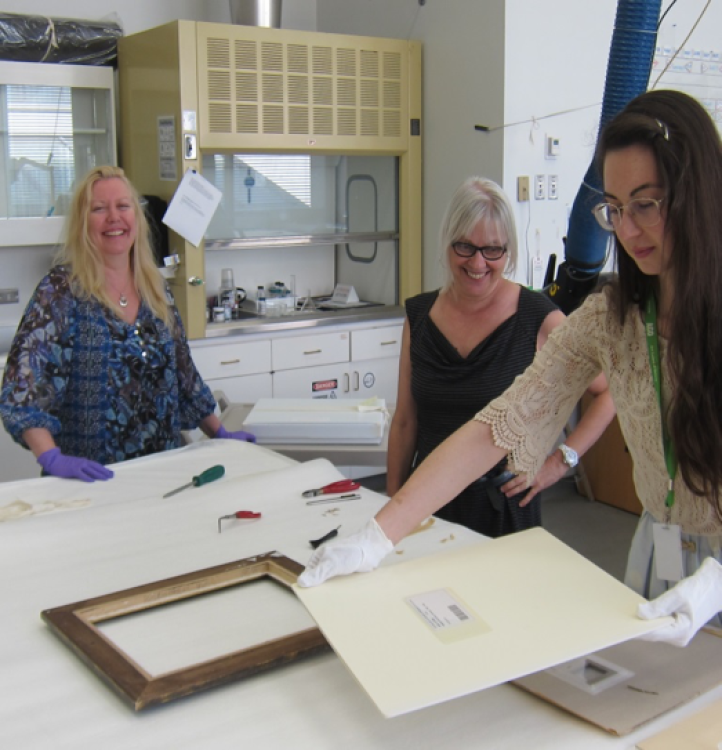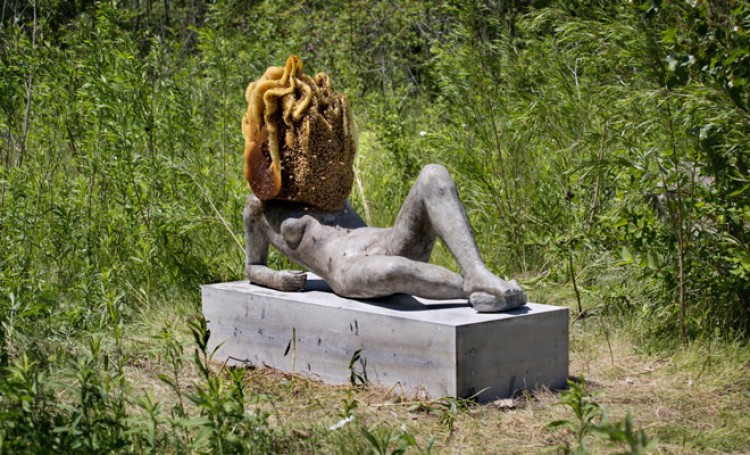Conservation Notes: A very fine resolution
 Prayer bead inside micro-CT scanner. Sustainable Archaeology, University of Western Ontario.
Prayer bead inside micro-CT scanner. Sustainable Archaeology, University of Western Ontario.
Micro-CT scanning prayer beads from the Thomson Collection
The AGO's Lisa Ellis, conservator of sculpture and decorative art, and Sasha Suda, assistant curator of European Art, travelled to the University of Western Ontario to answer questions about the intricate construction of two prayer beads from the Thomson Collection currently featured in the exhibition Idea Lab: Research at the AGO, Investigating Miniature Ivory and Boxwood Carvings, running from July 19, 2012, to April 2014.
 Micro-CT slice of prayer bead 29365 revealing construction methods and materials. Click to enlarge. (Prayer bead. Workshop of Adam Dirksz. AGOID.29365. The Thomson Collection © Art Gallery of Ontario.)
Micro-CT slice of prayer bead 29365 revealing construction methods and materials. Click to enlarge. (Prayer bead. Workshop of Adam Dirksz. AGOID.29365. The Thomson Collection © Art Gallery of Ontario.)
The complexity of the prayer beads has until now defied attempts to fully understand their construction. Some of these miniature carvings contain close to 100 separately carved elements. Traditional tools like X-radiography and microscopy cannot not fully explain how these objects were made — the way they are pieced together obscures joins from view and stacks elements, making it impossible to fully decipher the objects’ interiors with X-rays.
In order to understand these objects, we required much more sophisticated imaging. For help with our problem, we tracked down Dr. Andrew Nelson and doctoral student Zoe Morris from the University of Western Ontario's Department of Anthropology and Dr. Ron Martin from its Department of Chemistry. This highly specialized group of experts introduced us to micro-computed tomography, also known as high-resolution X-ray tomography or micro-CT scanning.
 Prayer bead. Workshop of Adam Dirksz. The Thomson Collection © Art Gallery of Ontario.
Prayer bead. Workshop of Adam Dirksz. The Thomson Collection © Art Gallery of Ontario.
The Sustainable Archaeology facility at Western University has a Canadian Foundation for Innovation–funded industrial Nikon Metrology XT H 225 system microtomography (micro-CT) scanner with a resolution so fine that it can distinguish details as small as 36 micrometers — a third of the diameter of a human hair — in the scans of the prayer beads. Just like medical scanners (which have a slice thickness of 600 micrometers), micro-CT scanners perform non-invasive studies to show internal features not of human anatomy, in this case, but of archaeological and bioarchaeological materials and now artworks.
Micro-CT scanning is now successfully exposing the construction secrets of these superlative carvings: scans of the two prayer beads have revealed hidden joins, pegs and adhesives. With the support of our collaborators at Western, the AGO team is eager to continue our micro-CT investigations into these fascinating objects and scan the remaining eight prayer beads in the Thomson Collection.
 Zoe Morris, University of Western Ontario, manipulating and interpreting the scans.
Zoe Morris, University of Western Ontario, manipulating and interpreting the scans.
More resources:
Learn more about the project in this CODART e-zine article by Lisa Ellis and Sasha Suda.
This animation is a surface rendered model of the prayer bead, created from a 21 gigabyte, three-dimensional volume of micro-CT data, using VGStudio MAX. Animation created by Zoe Morris. Courtesy of Sustainable Archaeology: Western University, 2012. Prayer bead. Workshop of Adam Dirksz. 1500-1550. AGOID 29365. The Thomson Collection © Art Gallery of Ontario.
Signature Partner of the AGO’s Conservation Program
Signature Partner of the AGO’s Conservation Program





